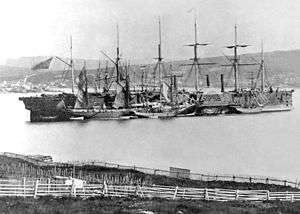Atlantic Telegraph Company
The Atlantic Telegraph Company was a company formed on 6 November 1856[1] to undertake and exploit a commercial telegraph cable across the Atlantic ocean, the first such telecommunications link.
 Great Eastern iron sailing steam ship, used to lay the Transatlantic telegraph cable. | |
| Industry | Telegraphy |
|---|---|
| Fate | 1870 merged with New York, Newfoundland and London Telegraph Company and French Atlantic Cable Company |
| Founded | 1856 |
| Founders | Cyrus Field, John Watkins Brett, Charles Tilston Bright |
| Headquarters | |
| Subsidiaries | Telegraph Construction and Maintenance Company |
History
The project stemmed from an agreement between the American Cyrus Field and the Englishmen John Watkins Brett and Charles Tilston Bright, and was incorporated in December 1856 with £350,000 capital, raised principally in London, Liverpool, Manchester and Glasgow. The board of directors was composed of eighteen members from the United Kingdom, nine from the United States and three from Canada. The original three projectors were joined by E.O.W. Whitehouse as chief electrician. Curtis M. Lampson served ably as vice-chairman for over a decade.
The board recruited the physicist William Thomson (later Lord Kelvin), who had publicly disputed some of Whitehouse's claims. The two enjoyed a tense relationship before Whitehouse was dismissed when the first cable failed in 1858.
When a second cable, under Thomson's supervision, was proposed, the Admiralty lent the hulks of HMS Amethyst and HMS Iris to the Company in 1864, both ships were then extensively modified in 1865 for ferrying the Atlantic cable from the works at Enderby's wharf, in East Greenwich, London, to Great Eastern at her Sheerness mooring. A new subsidiary company, the Telegraph Construction and Maintenance Company, under the chairmanship of John Pender was formed to execute the new venture.[2]
The cable was coiled down into great cylindrical tanks at the Wharf before being fed into Great Eastern. Amethyst and Iris transferred the 2500 miles (4022 km) of cable to Great Eastern, beginning in February 1865,[3] an operation that took over three months.
On the failure of the expedition to lay the second cable in 1865, a third company was formed to raise the capital for a further attempt, the Anglo-American Telegraph Company. Both the hulks and Great Eastern were put to use again in 1866 and again in 1869.[4]
The next expedition in 1866 was a success, also succeeding in recovering the lost second cable. The service generated revenues of £1000 in its first day of operation. The approximate price to send a telegram was: one word, one mile (1.6 km)= $0.0003809
The Atlantic Telegraph Company operated the only two trans-Atlantic cables without competition until 1869, when a French cable was laid. Shortly after this company was established, an agreement was made to coordinate pricing of telegraph services and share revenues, effectively combining the French and Anglo-American interests into one combine. A second French company, compagnie française du télégraphe de Paris à New-York, was established in 1879.
.jpg)
Anglo-American Telegraph Company
In 1870, the Atlantic Telegraph Company merged with rivals the New York, Newfoundland and London Telegraph Company, and the French Atlantic Cable Company to form the Anglo-American Telegraph Company.
Archive
Secretariat records (two volumes) of the Anglo-American Telegraph Company, 1866-1869, are held by BT Archives.
References
- The Trans-Atlantic Telegraph Cable 150th Anniversary Celebration 1858-2008 by Nigel Linge, University of Salford, 2008. Retrieved 4 September 2013. Archived 21 August 2013 at the Wayback Machine
- Russell, Sir William Howard (1865), The Atlantic Telegraph
- Russell, Sir William Howard (1865), The Atlantic Telegraph
- The Mechanics's Magazine, 30 October 1868 page 355.
Further reading
- Sharlin, H.I (1979). Lord Kelvin: The Dynamic Victorian. Pennsylvania State University Press. ISBN 0-271-00203-4., pp127-147
- Standage, T. (1998). The Victorian Internet: The Remarkable Story of the Telegraph and the Nineteenth Century's Online Pioneers. Phoenix. ISBN 0-7538-0703-3.